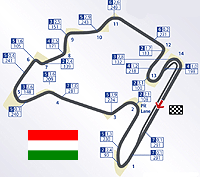 The Hungaroring presents plenty of challenges for drivers and engineers alike. The circuit features no high-speed corners, leading the team to run the highest possible downforce levels, while the primary concern for the engine team is ensuring good cooling in the usually hot conditions. The high summer temperatures also make life difficult for the drivers, who need to be in peak physical condition to cope with a race that gives them very little respite over its 70-lap distance.
The Hungaroring presents plenty of challenges for drivers and engineers alike. The circuit features no high-speed corners, leading the team to run the highest possible downforce levels, while the primary concern for the engine team is ensuring good cooling in the usually hot conditions. The high summer temperatures also make life difficult for the drivers, who need to be in peak physical condition to cope with a race that gives them very little respite over its 70-lap distance.
Aerodynamics
The twisting, 14-corner layout of the Hungaroring features just one legitimate overtaking opportunity per lap, into turn one. Apart from this straight of just over 700m, the circuit is filled with sequences of low to medium-speed corners, with short braking distances which make overtaking nearly impossible. The result is that the teams all run with maximum downforce levels, similar if not identical to those used in Monaco, in order to optimise not just cornering speeds, but also braking and traction. Maximum speeds achieved on the main straight rarely exceed 300km/h with the V8 engines.
"The circuit is quite intense for the drivers," says Fernando Alonso, "as there are so many corners in a short lap. The high levels of downforce mean we can be quite aggressive with the car, and the physical loads are high in the quicker corners. The section of track from turns 8 to 11 is all about accuracy, and anticipating the next corner. You need to find a good rhythm through the corners, and have confidence in a stable car balance to steer a smooth, quick course through this sequence."
Suspension
Mechanical grip is an important factor at a low-speed circuit such as this, and teams will generally try to run the car with softer settings all round to improve mechanical grip. The drivers want a responsive car in the low-speed sections, with good traction on corner exit, which will usually lead the teams to a forward mechanical bias (stiffer front/softer rear) in terms of set-up. However, rear tyre wear must be monitored very carefully, particularly to avoid overloading the softer compound available this weekend.
Tyres
Bridgestone will bring the soft and super-soft compounds from its 2009 range this weekend. The low-grip circuit conditions, coupled with the absence of high-speed corners, make these choices possible. As has become customary, the tyre management challenge for the weekend will be to control graining on the softest compound, and this should improve as the circuit rubbers-in throughout the weekend. Data collected during practice will determine whether the super-soft is suitable for use during the majority of the race, while cooler-than-expected temperatures, or overnight rain washing the circuit clean of rubber, could further complicate matters.
"The track is always quite green and dusty at the start of the weekend," says Alonso, "but it improves with every session and picks up a lot of grip as more rubber goes down. The first corner is the biggest braking zone and the only real overtaking opportunity on the circuit. It's a downhill right-hander that we approach in seventh gear at just under 300 km/h before braking down to 90km/h and downshifting to second gear. You need to take an early apex as the corner opens up on the exit so it's important to have good traction and get on the throttle early to carry good speed on the approach to turn two."
Cooling
Another important chassis parameter will be ensuring good cooling of the mechanical parts. Although the car's cooling capacity is now well-known, attention must be paid to ensuring the radiators are still well-cooled in spite of the high levels of front downforce we run at this circuit. This will have been the object of particular attention in the wind tunnel, and will be fine-tuned during the weekend to ensure the cooling solution required brings the minimum performance penalty.
Engine
With the longest period spent at full throttle barely exceeding ten seconds, and with only 56% of the lap spent at full throttle (significantly lower than the average), this is not a demanding circuit for the engine. Of the 14 corners, five are taken in second gear at around 100km/h. Unlike Monaco, where the cars reach abnormally slow speeds in the hairpins, the minimum speed at the Hungaroring is approximately 90km/h. This means the engine spends the majority of its time in a relatively narrow operating window between 100km/h and 250km/h, and the closely-spaced gear ratios we use are selected to ensure optimum performance in this range. As always on a circuit featuring a large number of slow corners, good torque is important to help launch the cars out of the turns.

 The
The 



















sign in